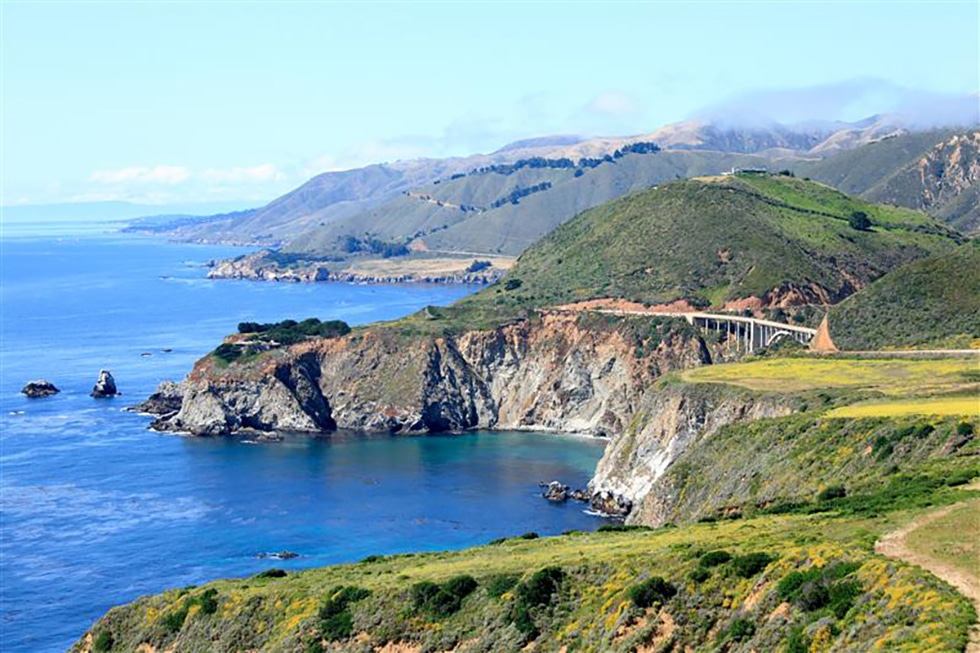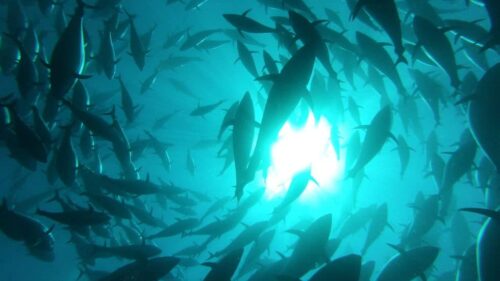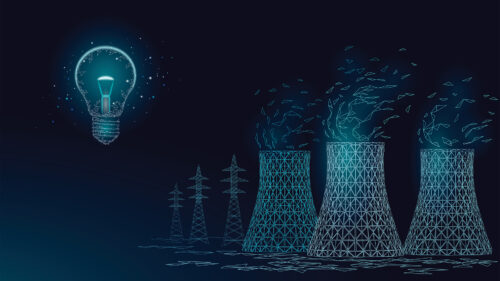The steep forbidding wilderness of Montara Mountain, a narrow ridge abuttin the famous San Andreas fault in Northern California, is a kind of perfect wilderness. We Coastsiders – that is, those who live along Northern California’s powerful, foggy sea – love this place for its Natural beauty. Except for a few power lines and radio towers, Montara Mountain is pure Nature: a wrinkled, rounded wall of granite, coated in brush and swirled in fog, waves crashing against cliffs at one end, deep forest glens at the other. This place is as close to Paradise as the urban Bay Area has access to, a place where people and wildlife exist side by side.
Here is what a Dark Park would do: it would coax and train people to blend into Nature, and as their reward they’d be saner and happier. Probably healthier, too. “Sensory Metrics of Neuromechanical Trust,” the technology research done by my wife Criscillia and myself eight years ago, mathematically proves that humans need to coexist with Nature to recalibrate our mental states. The peace and rejuvenation humans get from Natural spaces is real, measurable and the perfect antidote to the world of deadlines, monetization and screens.
In a Dark Park, the well-known ethos of “leave no trace” would be extended beyond litter to artificial light and sound as well. The less obtrusive we are, the more beneficial Natural stimuli are for our nervous systems. The filigreed fractals and sounds of Nature fit us perfectly. And now we can measure those filigreed fractals too, thanks to new technologies, and thus protect Nature better. The core concept of the Dark Park is to use instrumentation and Big Data to protect the wholeness of Nature, for everyone’s benefit.
Protecting the Natural from the un-Natural requires a statistical approach
There are three technological components needed to monitor the health of ecosystems in real time. The first two are obvious: hardware sensors and software processing, which I’ll get to later. But very few people know the third piece, the one I happen to be an expert on: what exactly to measure in the first place. The scientific phrase for this subset of quantitative biophysics is “natural statistics,” the measurement of patterns as they appear in their Natural form and format.
The field was started in the 1990s by my longtime neuroscience colleague Bruno Olshausen, now professor and director of UC Berkeley’s Redwood Center for Theoretical Neuroscience. He and others like Dan Ruderman took pictures of Nature and looked for common textures. Lo and behold, patterns emerged at scales slow to fast, tiny to vast: moss to mountains, ferns to forest, rivulets to rivers, patterns blending small to big in the “fractal” statistical format Nature uses the most. Those different scales seamlessly knitted together provide a full-scale moving 3-D picture of the ecosystem. Understanding all that data well enough to predict an ecosystem’s health must involve newly invented data technologies made originally for fields such as finance or astrophysics. Now these will be aimed not at measuring human consumers, but at Nature as She is, in order to protect Her.
With the development of sensor technology and statistical algorithms, we can now capture enough data to predict how Nature evolves in real time. Until now, much discussion about vibrations in Nature has been called “hippie talk.” This is because people were imagining that electromagnetic vibrations could be used to measure Nature, rather than plain old mechanical ones like motion, sound and ultrasound. We already know brains deal with exactly such mechanical vibrations.. So now we can apply battle-tested technology concepts such as signal format, information flow, carrier waves, phase, 3-D orientation, latency and resolution. In other words, now we have not only hardware and processing software, but also the crucial, quantifiable sensory metrics which encode organic trust and interaction.
The harmful effects of un-Natural light and sound can be measured
As relatable examples of how natural statistics works, let’s take blue light and traffic roar. In all species, for sensible physics reasons, the eyes are extra-sensitive to blue light. In the natural world, we’re not supposed to see any blue at night at all, so mere exposure — through a screen, or LED lighting, or car headlights — can induce sleeplessness, anxiety and headaches. To show how simple these effects are to measure, I offer some pictures from my lab-bench at home.
On the left is a graph of natural sunlight. It has very little blue. On the right is the spectrum from a LED headlamp. The shark’s-tooth blue spike on its left is the energetic source driving the other colors. Our eyes did not evolve for so much blue, and can’t adapt quickly.
Below are traces from two scientific instruments, an oscilloscope (left) and a frequency analyzer (right). The peaks and valleys show how light “screeches” in ultra-fast, on/off switches. This means the light from LEDs are “hyper-variable.” In fact, if this signal was connected to a speaker one could hear that the light sounds like a mosquito. Even though our nervous systems cannot sense hyper-variable light sources directly, we are still deeply irritated and destabilized by them precisely because they never existed in Nature.
The problem isn’t just too much blue light, but too much flicker. Flickering LED lighting is harmful, but also cheap and minutely more energy-efficient than less harmful kinds, so industry has blocked medical science from investigating the harms in the first place. Likewise, the roar of artificial traffic (like I heard growing up in Menlo Park, California) is unnaturally steady and regular, and is bad for us. The irregular roar of surf and wind are the exact opposite, and good for us. In general, the organic sounds and ultrasounds of Nature have just the right texture to relieve human stress.
Building a Dark Park is a team effort
But how to get a Dark Park up and running cost-efficiently? The same way all technology develops: by starting with what you’re already good at, learning fast, and then making the process fun. In my vision, the Dark Park will be constructed by three teams, formally adversarial but, at their core, deeply collaborative: Team Sensor, Team Prowler and Team Container.
Team Sensor tries to build a sensor which can “read” natural statistics in real time so that it can detect and track deviations, such as outsiders. Team Prowler, on the other hand, tries to sneak past those detectors in order to intimately learn their limitations. In other words, Team Sensor invents radar and Team Prowler invents under-the-radar evasion, both in tandem. Meanwhile, Team Container acts as referees, focusing on developing the park to make it fun for visitors. All three disciplines – scientific understanding, measurement technology and human behavior – get better by working together.
Team Sensor
Team Sensor would be my favorite to join, or just look in on. This team would be the first to read Nature in her native language, the language of ultra-bandwidth vibrations, using the very latest sensor and algorithmic technologies.
I imagine Team Sensor hits the ground running by first purchasing a bunch of cheap light-sensors ranging from the infrared to ultraviolet. Then, the team will hack up some amplifier circuits to measure light intensity by the microsecond. This is an unusual innovation which lets them track not only overall color spectrum, like the extra blue from screens or infrared from fires, but also the difference between the flickering of natural sources like bugs, and that of tech sources like LEDs.
After creating quick-and-dirty light analyzing gadgets, Team Sensor repeats the process, this time creating circuits that measure sound. Vibration-sensors will be able to map Nature’s sounds and tremors into the techno-language of Fourier power spectra (a representation of a signal’s power) and multiscale 3-D wavefront synchrony (the patterns that occur within a signal). They then hook all those measurement gadgets up to data-loggers in waterproof boxes, and plop them in nooks and crannies on Montara Mountain. They wait, and come back to harvest their data. Rinse and repeat.
With their new data about how Nature works, and how their gadgets work, Team Sensor can build algorithms into sensors that are able to interact with live people in real-time. I imagine the sensors looking like a streetlight in the forest, listening and looking for outliers. I call it a SenTree in honor of using sensors to guard Nature, and, of course, for looking like a tree. The firehose of Sentree data will make sure disturbances are caught long before anything actually goes wrong. It would emit noises depending on behaviors of the park-goers – whispering encouragement through hidden speakers to people who follow the rules, or growling disapproval at loud music and bright flashes.
Team Prowler
Meanwhile, Team Prowler gets a few of the sensors, so they can practice evading. By the time SenTrees go live, Team Prowler already has trickery up their sleeves. They’ll be able to “sneak up” on SenTrees and pinch their robotic butts – that is, know the weak points of the sensors. Can they learn to walk on gravel without being heard? Do irregular footsteps, like the “sandwalk” in the movie Dune, make sensing difficult? Do camouflage clothing make it harder to be seen? Is a phone a dead giveaway? A word? A grunt? A hand-signal?
The semi-adversarial approach in which Team Sensor and Team Prowler improve each other’s game is how the most potent algorithms, like AlphaGo, were able to evolve. After a few rounds both teams will be world experts on what Nature looks and sounds like, which technologies can measure Nature in real time and how the human form can move in ways which look like Nature.
Furthermore, if park-goers are actually encouraged to learn how to sneak past the SenTrees, they will naturally cultivate skills and sensitivities when interacting with Nature – tracker-level skills. These skills can be honed and respected in near-infinite directions, and taught to others. I bet some 12-year-old boys would enjoy learning physical spycraft. Visitors will learn how to respect the park. Personally, I would love to know that the visitors lurking in the forests facing my house are silent mountain scouts, not versions of the loudmouth Homer Simpson.
Team Container
Turning scientific insight into a public park is where Team Container comes in. They have the hardest job, that of inventing a whole new way for people to interact with each other and Nature. Team Container learns crucial cues from the Sentrees, and how their responses can be misinterpreted by humans.
Team Container will consult not only with designers of National Parks worldwide, but with designers of casinos, theme-parks, religious pilgrimages and ski resorts. Where does our species naturally flock, and what makes these places enticing? How can technology teach us to be our best selves? Team Container’s established practical knowledge will mix with Team Sensor’s dataset to make a best-of-breed technical specification for what park visitors should expect as rules and guidelines. In this way, Team Container acts as both translator and host for the Dark Park.
If Team Sensor, Team Prowler and Team Container do their job, the Montara Dark Park will protect a local wonder of Nature while also making it accessible to more people than a normal campground could. Active, sensitive, neutral monitors will “gamify” the park experience to nudge park-goers into treating Nature with respect, thereby allowing more visitors to have better experiences while simultaneously preserving Nature.
A Dark Park teaches the spirit of collaboration
Usually, parks will have rules to protect Nature, so the concept of rules in parks is nothing new. Some places ban people altogether. There are rules about campfires and smoking and multi-weeks stays, and rules for touching walls in caves. In most situations there is a near-religious commitment to “leave no trace,” neither litter nor stain.
In the Dark Park, it’s not just the rules, but the spirit of the rules, that will protect Nature. As a general rule people like to collaborate and help (yes, even 12-year-old boys). If the spirit of the park is not to bring gadgets or cause ruckus, the people who attend will self-select and naturally help others keep resolve.
Visitors to the Dark Park will be happy to be there. If they are told about natural statistics, shown the subtle beauty of quiet and are encouraged to blend in, they will join in eagerly, help their friends, and strive to protect Nature.
[Coastside Buzz first published this piece.]
[Cheyenne Torres edited this piece.]
The views expressed in this article are the author’s own and do not necessarily reflect Fair Observer’s editorial policy.
Support Fair Observer
We rely on your support for our independence, diversity and quality.
For more than 10 years, Fair Observer has been free, fair and independent. No billionaire owns us, no advertisers control us. We are a reader-supported nonprofit. Unlike many other publications, we keep our content free for readers regardless of where they live or whether they can afford to pay. We have no paywalls and no ads.
In the post-truth era of fake news, echo chambers and filter bubbles, we publish a plurality of perspectives from around the world. Anyone can publish with us, but everyone goes through a rigorous editorial process. So, you get fact-checked, well-reasoned content instead of noise.
We publish 3,000+ voices from 90+ countries. We also conduct education and training programs
on subjects ranging from digital media and journalism to writing and critical thinking. This
doesn’t come cheap. Servers, editors, trainers and web developers cost
money.
Please consider supporting us on a regular basis as a recurring donor or a
sustaining member.
Will you support FO’s journalism?
We rely on your support for our independence, diversity and quality.









Comment